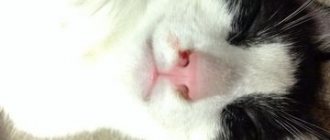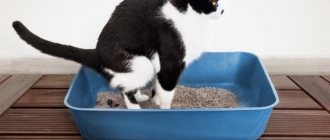If your cat is sneezing and has bloody discharge from his nose
First of all, if you notice red discharge from the nose when your pet sneezes, you should not panic. Sometimes this happens if the animal's nasal capillaries are too close to the surface. And then, when excited, the pet may bleed from the nose.
If, when sneezing with blood, the bleeding does not stop, then it is possible to help the animal by placing a cold object on its back - this will serve as a signal to the capillaries, and they will narrow. Eventually the bleeding should stop.
If all these procedures do not help the animal who is sneezing, you should seek help from a veterinarian.
Veterinary assistance when visiting the clinic
First aid will definitely be aimed at stopping the bleeding. All subsequent manipulations and treatment procedures will be carried out only after an accurate diagnosis has been made and the reason why the cat is bleeding has been determined.
Means for symptomatic stopping of bleeding from the nasal cavity:
- Adrenaline in a dosage of 0.02-0.05 ml (1:1000) subcutaneously (cannot be used if nosebleeds are associated with lung injury, as it dilates the pulmonary vessels).
- Antipyrine 20% or hydrogen peroxide for wetting thin cotton-gauze swabs that are inserted directly into the nasal passages.
- Ephedrine 2% (with caution) subcutaneously or into the muscle in a dose of 1-30 mg under strict supervision. Do not use in pregnant women or with high blood pressure. Used for prolonged rhinitis with blood.
- Calcium chloride or gluconate 10% - slowly intravenously in a dose of 5-10 ml, depending on the intensity of the pathology.
- Vikasol - into the femoral muscle at a dose of 1-2 mg/kg body weight (usually 10 mg of vitamin K in 1 ml of solution), after warming the ampoule in your hands.
Recommended reading: pig mug
If the cat continues to bleed from the nose and his general condition worsens, a decision is made to put the animal under anesthesia for diagnostic surgery. Identified causes are eliminated immediately after identifying the source of bleeding in various ways (removal of tumors or foreign objects, coagulation of blood vessels, etc.).
Depending on the type of infectious disease identified, antimicrobial, antiviral or antifungal therapy is prescribed. In case of extensive blood loss - restorative-replacement drips.
What to do if your pet sneezes and produces blood
If a cat is constantly sneezing blood, this is the case when you should immediately contact a veterinary clinic for examination and treatment of the cat. After all, only a doctor can make a correct diagnosis if a cat develops snot and sneezing. The causes of sneezing with blood can be caused by various diseases :
- Damage to the nasal passages by foreign objects;
- Injury;
- Dental problems;
- Oncology;
- Hypertension;
- Poor blood clotting;
- Fungal infection.
If, while sniffing an object, a midge or other foreign body gets into the nasal cavity, the animal tries to get rid of it by sneezing and coughing.
What is the connection between nosebleeds and periodontal diseases (periodontal tissues)
Cats have a thin jawbone in their upper jaw and very long molar roots. If the tooth and/or alveolar tissues are affected by severe, advanced inflammation, then microorganisms, their waste products and tissue decay elements easily enter the nasal cavities. The inflammatory process in this place is necessarily accompanied by damage to blood vessels and capillaries, because this area is very well supplied with blood. Bleeding will not take long to occur, ranging from minor capillary to serious and intense.
Symptoms of cat sneezing that should alert you
Allergies in cats
Let's start with the fact that sneezing is a normal physiological process. But sometimes an animal can behave quite suspiciously, not as usual. Frequent sneezing is one of these noticeable symptoms. It must be understood that obvious violations indicate that the animal has health problems.
It often happens that the sounds made by a pet represent a typical allergic reaction. After all, every body can contain “personal” allergens, that is, substances that can cause allergies. Commonly encountered ones include: dust, pollen, mold, candle wax, cigarette smoke. It is necessary to remove as strong odors as possible, because they can make any animal’s eyes water.
These are the possible situations associated with sneezing. The reasons for this may also lie in pathologies of the fluffy’s nasopharynx. It happens that polyps or growths appear in the nasal sinuses of cats. It is because of this that animals may feel like they are short of air. You just need to listen to your pet and pay attention to its behavior. If there is shortness of breath, if the cat (or cat) sniffles with its nose, and also periodically breathes through its mouth, then in most cases the cause is polyps. The owners of furry animals can see them themselves; simply point a flashlight into the animal’s nasal passages to see the pinkish growths.
Cats can also sneeze due to an asthma attack. Usually he goes “in company” with coughing and sneezing. Often the development of asthma occurs due to allergic reactions that become chronic. The most basic assistance that can be provided in this case is to hold the animal’s face over water vapor for about two minutes. The hot steam will dilate the bronchi and other airways and make it easier for the cat.
Why a cat may sneeze - find out the reasons
Veterinarians believe that rare and one-time sneezing is normal for an animal. The reason for this reaction of the body may be:
- overexcitement
- irritants in the nose
- long movement
Sneezing caused by these factors occurs quickly and does not cause any discomfort to the animal. Prolonged attacks are the result of more serious problems. The most common causes of sneezing are:
- Diseases
- Allergic reaction
- Chlamydia
Diseases that cause sneezing can be different: nasal polyps, colds, nasal cancer, viral pathologies. Of the viral infections that cause sneezing, feline herpes is the leading one. The cause of infection is other animals with which the pet comes into contact, stress, and weakened immunity of the body. When infected with the virus, the cat becomes lethargic, loses appetite, sores appear in the mouth, and the eyes water. Important! If you notice symptoms of a viral disease in your pet, you should not treat the cat yourself. The veterinarian will make an accurate diagnosis and prescribe medications for therapy. Allergies are the second most common cause of sneezing in cats. To find out why a cat is sneezing and clarify the reasons, the owner should pay attention to what the animal has an acute reaction to and isolate the object causing the problem. Most often, cats are sensitive to:
- various sprays
- poor quality toilet filler
- mold
- smoke
- dust
Aerosols penetrate deeply into the animal's olfactory organs and irritate the nasal mucosa. Regardless of whether it is perfume or a disinfectant, cats’ delicate sense of smell reacts painfully to unnatural odors. Cat litter contains ingredients that eliminate unpleasant odors. Many companies in the production of litters use high-quality raw materials that do not cause allergies in cats. Some companies save on materials and produce fillers with cheap components that cause allergies in animals. On walks, animals can find mold fungi. Spores easily enter the animal’s nose, since it is through sniffing that the animal examines objects. Cigarette smoke also negatively affects cats' delicate sense of smell. In this case, sneezing becomes a protective reaction of the body to an external irritant. Important! Bad teeth (and this happens in cats) are also the cause of an animal’s sneezing. Some types of dust cause allergies not only in people, but also in animals. Among the most harmful types of dust for the body is book dust.
The cat sneezes blood. Reasons for this
Problems with a cat's nose
A fairly common question among furry pet owners is: why does the nose bleed when the animal sneezes? It must be said that this happens for completely different reasons: from ordinary dust, which is usually not paid attention to, and a stuck piece of food to quite serious health problems.
When a cat sneezes blood from the nose, this is not a very good sign, because the cause could be a rather serious illness.
Why does bleeding start? Anyway, why do pets get nosebleeds? Before answering these questions, you need to understand what it is. This whole situation means that blood clots are coming out of the animal's nose.
The main causes of bleeding can be oncological lesions (tumors in the nose - as a rule, this is observed in old cats), the entry of a foreign body into the nasal passage, mechanical damage to the respiratory tract with a sharp and fairly hard object that gets into the nose or touches it, processes can be disrupted blood clotting (in other words, blood clots do not form as they should), dental infection (imagine, cats have toothache too), high blood pressure.
It is unlikely that the owner himself, at home, will be able to very carefully examine his pet’s nose to understand whether there is damage there. Understanding why a cat sneezes blood and what to do in such a situation in order to eliminate it is possible only after a consultation with a veterinarian.
If your cat has been sneezing blood for several days in a row without stopping, you should immediately contact a veterinary clinic. After all, at home it is quite difficult to understand the cause of what is happening and provide adequate help. First aid should be provided according to the situation - first you need to stop the bleeding. If there are traces of cuts or scratches on the nose, then you need to treat them with an antiseptic (preferably one with a mild smell), a spray for cats, or a special wound-healing ointment.
It has already become clear why the cat sneezes blood. The reasons for this are stated above. One more point should be noted: the owner of the animal can, if a foreign object gets into the nose, inspect it by illuminating it with a flashlight. If he finds something there, you can try to get it out with small tweezers. But if this doesn’t work, then you shouldn’t risk the animal’s health and rush to the vet.
If blood comes out when you sneeze
The owner should pay close attention to such a symptom as the cat sneezing blood. This indicates that the pet has damage to the nasal passages, resulting in bleeding. In order to find the answer to the question of why a cat sneezes with blood discharge, you will have to consult a veterinarian. Only he will be able to determine the main causes of this condition and, as a rule, they are:
- Mechanical damage to the respiratory tract.
- Various fungal diseases.
- Oncological diseases.
What should you do if your cat sneezes and produces blood? First of all, don't panic. Carefully inspect the nasal passages and oral cavity for the presence of foreign substances. Your pet may get stuck with a bone or part of a toy. All this irritates and scratches the mucous membrane, which causes him to cough and sneeze with blood. If the cat does not have any foreign bodies, then you need to go to the veterinary clinic for an examination and begin treatment as quickly as possible.
How to treat a cat for sneezing?
Examination of a cat at the veterinarian
Any treatment must be prescribed by a doctor. This will depend on the reason that provokes this sneezing. If the veterinarian does not find any diseases in the animal, he may recommend the use of regular house cleaning or a special air humidifier.
If a cat has respiratory tract diseases, the animal will need nasal medications to eliminate swelling. If the case is much more serious, it will be necessary to undergo a course of treatment with antibiotics. If necessary, the veterinarian will prescribe surgery. The owner of the animal, who has found out what happened to his pet, must follow exactly all the recommendations of the specialist and do everything he says. After all, it is necessary to carry out the prescribed procedures in a timely manner. The veterinarian may prescribe tablets, injections, or nasal drops.
But when taking care of your pet furry, you must also maintain personal hygiene. If necessary, use gloves and a protective mask.
Preventive actions
In this article, we were able to find out why a cat sneezes blood (blood from an animal’s nose when sneezing can be a really serious symptom). But first of all, this can happen due to the presence of allergens in the house or dust getting into the animal’s nasal passages. Therefore, wet cleaning should be carried out frequently using safe cleaning products.
And to exclude dangerous diseases, it is necessary to carry out timely vaccination. Starting from six months, you should follow the established schedule of vaccinations, carrying them out against rabies, leukemia and leukopenia, and cat flu. The main thing is that regular preventive examinations are carried out by an experienced veterinarian who will be able to detect impending danger in time and begin treatment in time.
Don’t wonder why your cat is constantly sneezing. You need to hurry up and help your furry friend.
Diagnosis by a veterinarian
First of all, the veterinary specialist needs to provide complete information not only about the condition of the animal at the time of treatment, but also the lifestyle the day before.
A sample list of questions to determine the cause of a cat’s nosebleed is as follows:
- Has the owner or his family given you any medications in the last few days? Which ones exactly? For what purpose? Dosage?
- Have rat baits been used in the house? Is it possible for a cat/cat to gain access to them?
- Have you had contact with other cats? Fights?
- Could the cat injure itself - fall, get hit by a car, or someone could hit it?
- Is there watery eyes, snot, or sneezing? Does the cat rub its face with its paws?
- Is the bleeding one-sided or two-sided?
- Vomit? Character of vomit? Before the blood appears or after?
- State of stool? Is there blood in the stool?
- Are there problems with your mouth and teeth? Do you have bleeding in the mouth? Are the mucous membranes pale? Is there marbling?
- Does the cat have any signs of hemorrhage or swelling in its body (suspicion of subcutaneous bleeding).
- Is your pet breathing normally? Wheezing due to excessive blood flow from the nostrils?
- Allow your pet to be examined by a doctor for deformation of the muzzle, swelling of the bridge of the nose and any asymmetry. Are there any changes in the eyeballs? Tears?
We recommend reading: A new drug for the treatment of mastitis and surgical diseases of the skin and mucous membranes – “Septogel”
In addition to collecting a detailed history (living conditions) of the animal, it may be necessary to do a number of tests and clinical tests:
- general analysis of blood and urine, as well as their biochemistry (allows you to assess the state of the cellular composition and the presence of red blood cells in the urine);
- serological tests to determine the presence of rickettsia and fungal agents;
- checking the status of blood pressure (normally, a cat’s indicators should be at the level of 120/70 – 180/130, depending on the age and condition of the cardiovascular system);
- rhinoscopy, and, if necessary, an x-ray of the nose;
- X-ray of the chest (blood from the nose and mouth may appear due to rupture of the lungs and other pulmonary lesions);
- deep endoscopic examination;
- biopsy of the mucous membrane from the nasal passages;
- diagnostic surgery.
Some of the diagnostics listed may require local or general anesthesia!
Only after collecting anamnesis, clinical examination and appropriate tests can an accurate analysis be performed and adequate treatment prescribed!
Cat sneezes blood
Any bleeding in a pet causes strong emotions in owners: from anxiety to panic. Nothing human is alien to cats, and therefore they are susceptible to nosebleeds no less than people. Sometimes this is a single manifestation of some temporary disorder, sometimes it is a signal of a serious illness.
Let's figure out why a cat's nose bleeds when sneezing, and how you can help it.
First aid for nosebleeds
The appearance of blood from a cat's mouth or nasal passages leads the owner of the animal into a stupor or panic. It is necessary to calm down and carefully examine the pet, thus assessing the severity of the situation.
Next, it is important to calm the pet as much as possible, which will normalize blood pressure and prevent increased bleeding. You should not give your cat human sedatives on your own without first consulting a specialist.
Severe bleeding from the cat’s nose must be stopped by applying a cold compress to the back of the animal’s nose, and then taken to the clinic.
In a clinical setting, the animal will undergo a comprehensive clinical examination to make an accurate diagnosis and prescribe adequate treatment. Diagnosis of nosebleeds includes several laboratory tests:
- blood biochemistry;
- cytological examination;
- general blood analysis;
- urine analysis (to assess the functioning of the kidney structures).
A more thorough examination includes endoscopy (if gastric blockage is suspected), x-ray examination of the sinuses, rhinoscopy and computed tomography. Additional diagnostic methods include conducting serological tests if a fungal infection or disease caused by ticks is suspected.
Types and causes of nosebleeds
Animals can bleed from the nose with varying intensity. The more blood is released, the more dangerous the condition may be and the faster you need to provide first aid. Bleeding can vary and be manifested by the following symptoms:
- the appearance of mucus streaked with blood when sneezing (indicates a strong inflammatory process and fragility of the capillaries of the mucous membrane);
- the appearance of droplets of scarlet blood when sneezing;
- constant discharge of blood from the nose;
- a trickle of blood from one or both nostrils.
Liquid entering the nose always provokes sneezing, so with any nosebleed the animal will begin to sneeze.
The reasons why a cat sneezes blood often lie in general problems in the functioning of the body:
- blood clotting disorder: decreased platelet levels (including in autoimmune processes, feline viral immunodeficiency) or a violation of the coagulation system (for example, in case of rat poison poisoning or liver failure);
- severe increase in blood pressure (cats can suffer from hypertension just like people).
These conditions are characterized by moderate to severe nosebleeds and are excluded primarily by performing a clinical and biochemical blood test, as well as measuring blood pressure. To make a diagnosis and to exclude pulmonary hemorrhage, doctors may suggest taking an X-ray of the chest, as well as the animal’s head, and rhinoscopy.
If a cat has snot, and he sneezes blood, and also has other symptoms, then perhaps he has caught some kind of infectious disease - bacterial, viral, fungal or parasitic (you can read more about this in our article “The cat has a runny nose and she is sneezing : how to treat?").
Very often the cause is a muzzle injury. If the cat's nose and muzzle look asymmetrical, swelling of any area is observed - this may indicate a fracture of the skull bones or severe inflammation.
A foreign body can get into the nose - some plants with hard awns, such as rye and wheat, are especially dangerous. If a cat walked across a field, it can be assumed that one of these spines has penetrated the nasal passages - this can be easily detected by a doctor during rhinoscopy.
Tumors can develop throughout the respiratory tract, the existence of which the owner may not be aware of. The destruction of such a formation or its injury can cause severe bleeding due to the good blood supply to the tumors.
One of the symptoms of the development of chronic inflammation in the sinuses is the unilateral secretion of mucus mixed with blood.
All possible causes of blood
There are many reasons for a cat's nose to bleed. The most common are:
- swelling and bleeding of the nasopharynx due to injury due to blows (kicks) or scratches during a fight;
- foreign object entering the nostrils;
- protracted infectious diseases (often accompanied by snot with blood);
- the presence of neoplasms (tumors) in the cat’s nose;
- diseases of the blood system (incoagulability, blood parasitic diseases or disruption of cellular composition at the platelet level, cancer (leukemia));
- penetration of parasites (worms) into the nasal cavity;
- surges in blood pressure (genetic predisposition, heat stroke, stress or fear, etc.);
- pathologies of teeth and gums (often accompanied by bleeding from the nose and mouth);
- poisoning by rat poisons;
- prolonged exposure to fungal formations (for example, candidiasis) or purulent discharge (the mucous membrane directly melts under the influence of pus and bleeding increases);
- individual reaction to medications (for example, Warfarin);
- cutaneous blood-sucking parasites (their active life activity affects the composition of the blood and its ability to clot).
First aid for a cat with a nosebleed
So, the cat has blood coming out of its nose. If a runny nose initially occurs and streaks of blood appear in the mucus, this condition is most likely not critical, although it also requires certain actions (more about this in the article “What to do when a cat sneezes and has snot?”).
The release of drops, and even more so a trickle of blood, can seriously frighten the owner. What to do if your cat has a bleeding nose? First of all, put off panic. The owner's anxiety can agitate the pet, and this will lead to increased blood pressure and, as a result, increased bleeding.
Try to calm down: now the health of your beloved animal depends on your composure. Provide your pet with silence and a calm environment.
If moderate to severe nosebleeds develop, it is better to adhere to the following algorithm of actions:
- Apply something cold to the bridge of your nose, such as an ice pack or something wrapped in a cloth from the freezer. This must be done in such a way as not to prevent the animal from breathing freely.
- Find out where the nearest veterinary clinic equipped with a rhinoscope is located. If there is no one nearby, then go to any other one or call a veterinarian at home.
- While you are waiting for a doctor's examination, if possible, carefully examine the animal yourself - its face and mouth. Remember what medications you gave the cat, whether there was access to the street, etc. If the animal feels unwell, has pale mucous membranes and rapid breathing, and the bleeding continues, then the clinic can see you without a queue.
If veterinary care is not available, cold treatment should be applied until the bleeding subsides. You can gently rinse your nose with aminocaproic acid - this is a hemostatic agent sold in a regular pharmacy. We talked in detail about the technique of rinsing the nose of cats in the article “What to do at home if a cat sneezes?”
Unfortunately, it is impossible to determine the exact causes at home - only a specialist can do this.
Signs of a serious illness
Experts identify quite a few diseases that provoke poor blood clotting. In case of illness, the animal may also experience other symptoms - for example, red spots on the ears and gums, pale gums. Also, the cat may not want to get out of bed in the morning and will lie all day due to loss of strength and lethargy.
Blood in a cat from the anus, in a cat and a kitten
Reduced blood clotting in cats can occur due to diseases such as viral leukemia and viral immunodeficiency. It can be caused by side effects of anti-inflammatory drugs. Another common reason is as a result of pathologies of the systems responsible for blood clotting, for example, disseminated intravascular coagulation syndrome, liver failure, hemophilia.
Note! Severe purulent discharge with blood from the eyes or nose may also indicate the presence of worms.
Blood when sneezing
Bleeding when sneezing can be caused by inflammation or irritation of the nasal mucosa. As a result of prolonged and severe sneezing, heavy bleeding may occur, as well as a slowdown in natural blood clotting.
Blood when sneezing
If your pet does not stop sneezing blood for a long time (more than 1-2 days), you should urgently contact a veterinarian. At home, it is very difficult to determine the cause of the disease, much less help the animal. First aid can be effective depending on the situation, but if the cause of the bleeding is unclear, then doing it on your own can even harm the cat.
Note! If cuts and scratches are noticed in the nose, they will need to be treated. For this, it is best to use an antiseptic without a strong odor, a spray for cats, or a special wound-healing ointment.
Flux or periodontal disease
If you have symptoms of periodontal disease or gumboil in case of bleeding in the nasal cavity, you should contact your veterinarian. The pet's nasal or oral cavity may become swollen, which will become a serious obstacle to the animal's normal functioning.
Unpleasant smell
Bloody nasal discharge in animals may be accompanied by an unpleasant odor. The reasons may be different, for example, an unpleasant odor may occur as a result of foreign bodies entering the nose. If a cat sneezes with blood, the nasal discharge is green and has an unpleasant odor, then most likely the pet has picked up some kind of virus. These same symptoms appear in leukemia, so they should not be ignored.
Important! Diagnosis and treatment should be carried out exclusively by a specialist - inadequate assistance will only do harm.
Labored breathing
Difficulty breathing accompanied by bleeding may indicate swelling in the nasal cavity. These can be either malignant neoplasms or swelling as a result of inflammation or an allergic reaction. The cause may also be a foreign body that has entered the nasal cavity.
The kitten has lost its appetite and is having difficulty breathing
Loss of appetite
Loss of appetite, general weakness and lethargy are most often observed in infectious diseases. Sometimes an animal may refuse to eat due to pain in the mouth and nose while chewing. In this case, the pet should be checked for tumors in both cavities.
How are nosebleeds treated?
Of course, veterinarians treat the disease that caused this unpleasant symptom. Animals with infections are given antibiotics and other drugs, with hypertension, blood pressure is reduced, and in case of poisoning, toxins are removed.
If tumors are found during the study, doctors take pieces of them for analysis - they do a biopsy. Only after this can the possibility of performing operations to remove these tumors be assessed. Complex injuries and deep penetration of foreign bodies are treated surgically.
In addition to eliminating the cause, symptomatic treatment is also prescribed to reduce the likelihood of bleeding. To do this, the animal is given injections of substances that promote blood clotting (drugs such as Ditsinon and Vikasol are most often used).
We have taken a detailed look at the information that an owner needs to know about nasal bleeding in cats. We hope that knowledge and confidence in your actions will help you provide first aid to your cat if necessary.
What are the types of bleeding in cats and their symptoms?
Bleeding is divided into acute and chronic. Chronic bleeding is characterized by constant bloody drips from the nose. Acute bleeding begins abruptly and is practically asymptomatic.
In addition, bleeding is divided into bilateral and unilateral. It is important to understand that unilateral bleeding (the appearance of blood from one nostril) more often signals the presence of a foreign object in the nose, a tumor process, or mechanical injury.
If blood flows from both nostrils, the cause lies in infectious lesions of the respiratory tract or intoxication with zoocoumarins.
If the following symptoms appear during a nosebleed, it is recommended to immediately consult a veterinarian for help. The following signs are dangerous:
- the appearance of blood when sneezing;
- discharge of blood from the nasal sinuses, accompanied by signs of periodantosis or gumboil;
- the appearance of blood from the nose and mouth (there is a high probability of damage in the cat’s mouth);
- staining of feces black (feces become tar-like due to internal bleeding, while there may be no blood from the nasal passages);
- the appearance of an unpleasant odor from the mouth and breathing of the animal;
- violation of the act of breathing (shortness of breath, noisy inhalation and exhalation);
- loss of appetite.










